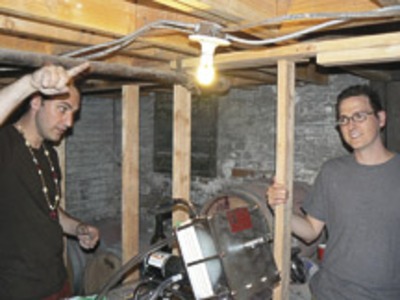Todd Fertig is not looking to be Ernest and Julio Gallo, Robert Mondavi, or even Francis Ford Coppola. He just makes wine as a creative hobby.
Fertig, a Pittsburgh native who lives with his wife and 3-year-old daughter in Downtown Jersey City, took up winemaking about eight years ago and has continued to pursue it. Last October, he led a group of about 20 people to crush hundreds of pounds of grapes, creating juice that was then poured into seven oak barrels.
Those barrels were stored in the basement wine cellar of a Wayne Street house belonging to friends, where the juice sat and fermented for more than nine months. Then it was time to invite the friends back and enjoy the fruits of their labor.
On Aug. 8, the wine was retrieved from the barrels. It was then poured into approximately 1,500 bottles with the help of the same group that was there at the beginning.
“This is the equivalent of someone coming into the delivery room and seeing me having a baby,” Fertig said. “We also hope to do a little bit of work and have a little bit of fun.”
A celebration
However, taking wine out of barrels is not entirely a barrel of fun. That comes later, after blocking out a pleasant summer day to allow for an amateur chef to prepare world-class lunch and dinner, having classic rock blasting from an iPod Player and savoring homemade vino.
Enjoying the day was Jennifer Wong, who lives in the house where the wine bottling party took place. Wong is a wine lover who has done her share of California wine country tours.
“I like the whole creative process, especially so close to home,” Wong said. “And I get 150 bottles of wine.”
From grape to wine and beyond
Making wine is a process that is a mixture of art and science.
The grapes used for the wine, shipped in from California last October, were crushed the same day they were delivered to Fertig. The crushed grapes, called “must,” are then stored in garbage bags. Yeast is added to the crushed grapes for fermentation, or the conversion from grape juice to alcohol.
“This is the equivalent of someone coming into the delivery room and seeing me having a baby.”— Todd Fertig
________
That’s where they sat until the Saturday afternoon when the wine was removed.
Before any wine is taken out of the barrels, there is a cleaning process where any equipment that touches the wine must be cleansed with a sulfate solution that is not harmful to the wine.
As Fertig put it, “The key to winemaking is cleanliness.”
Once the cleaning process is complete, the wine is pumped out of the first barrel with a tube attached to a machine that sucks out the wine and pours it into a glass carboy, a five-gallon glass container. As it is poured into the carboy, it goes through a filter to take out any bacteria that can be harmful to the wine. The wine in the carboy is then funneled out of the carboy and into the bottles, an activity that takes up most of the day.
Darren Devleeschouwer, a friend of Fertig’s living in Downtown Jersey City, was among those helping him.
“I always hear Todd talk about it but I had no idea,” Devleeschouwer said. “I think it’s cool and we get to drink a lot of wine.”
After the wine was filled in the bottles, they were corked in the backyard of the house. The corking was done by Fertig’s wife with the help of a few friends. Others were either washing out the glass bottles, passing the bottles through the basement window, or storing the bottles that could not be taken home by the guests who came by for the afternoon.
When the first bottle was corked, Fertig presented it to the small group that assembled in the backyard, cradling it in his arms like a newborn.
Ricardo Kaulessar can be reached at rkaulessar@hudsonreporter.com.
